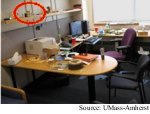|
NEWS
|
RFID tag spotter
 How often do you lose your keys? A combination
radio frequency identification tag reader and digital
camera that displays the location of tagged objects is
poised to help. Camera phones with the technology onboard
would locate tagged items like keys. The device could
also track real objects in virtual and augmented reality
environments. (Ferret:
RFID Localization for Pervasive Multimedia, UbiComp
2006, September 17-21, 2006)
How often do you lose your keys? A combination
radio frequency identification tag reader and digital
camera that displays the location of tagged objects is
poised to help. Camera phones with the technology onboard
would locate tagged items like keys. The device could
also track real objects in virtual and augmented reality
environments. (Ferret:
RFID Localization for Pervasive Multimedia, UbiComp
2006, September 17-21, 2006)
Chip runs on radio
A tiny computer with no batteries or wires is
powered remotely by radio waves. The chip, powered and
read by radio frequency identification tag readers, could
be used to make lightweight, inexpensive sensors. (A
Wirelessly-Powered Platform for Sensing and Computation,
UbiComp 2006, September 17-21, 2006)
Muscling up color displays
A diffraction grating made from electrically-driven
artificial muscle turns white light into a wide range
of colors. The device could be used to make high-fidelity
displays that more accurately reproduce the colors humans
perceive. Today’s displays are less accurate because they
generate colors by mixing red, green and blue. (Polymeric,
Electrically Tunable Diffraction Grating Based on Artificial
Muscles, Optics Letters, September 1, 2006)
Microfluidic refrigerator
A set of tiny gas- and fluid-filled channels cools
chips as fast as 40 degrees Celsius per second. The microfluidic
device could be used to cool high-performance computer
chips and scientific equipment. (Evaporative
Cooling in Microfluidic Channels, Applied Physics
Letters, August 14, 2006)
Laser-in-a-biochip
A microfluidic channel with a built-in laser is
a key advancement in making chip-size laboratory equipment.
The device could be used for positioning and analyzing
cells and other particles in biochips. (Monolithic
Integration of Microfluidic Channels and Semiconductor
Lasers, Optics Express, August 21, 2006)
Sensitive foam
A thin-film transistor with a layer of special
rubber foam that produces an electric field when deformed
makes for a touch or pressure sensor. The sensor could
be used to make sensor skins for robots and smart rooms,
and microphones. (Flexible
Ferroelectret Field-Effect Transistor for Large-Area Sensor
Skins and Microphones, Applied Physics Letters, August
14, 2006) |
FEATURES
|
View
from the High Ground: ICL's John Pendry
Physics as machine tool, negative refractive
index, metamaterials, shattered wine glasses, higher capacity
DVDs, scientific backwaters, risk perception and practice,
practice, practice.
|
How
It Works: Quantum computing: qubits
Photons, electrons and atoms, oh my! These particles are
the raw materials for qubits, the basic building blocks
of quantum computers. |
|
 |
News RSS feed 
Blog RSS feed 
Bookshelf RSS feed

New: TRN's
Internet Services
TRN's Jobs Center
|
| |
|
| |
|
| |
"Physics
is to the rest of science what machine tools are
to engineering. A corollary is that science places
power in our hands which can be used for good or
ill. Technology has been abused in this way throughout
the ages from gunpowder to atomic bombs."
- John Pendry, Imperial College London |
|
| |
|
| |
Thanks
to Kevin from
GoldBamboo.com
for technical support |
|

